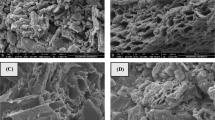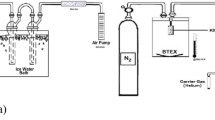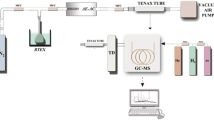Abstract
Exposure to BTEX concentrations may have a remarkable influence on human health because of their existence in indoor air. It is the only solution to remove BTEX from the environment by either ventilation or filtering. Activated carbon is the primary carbon-rich material for the BTEX pollution control strategy. In this study, Digitalis purpurea L. biomass as lignocellulosic materials was selected as a common substance in nature and carbonization-appropriate processing. The activated carbons (DPAC1-60) were prepared from the pyrolysis of Digitalis purpurea L. biomass at 500–900 °C by chemical activation with Zinc chloride (ZnCl2), Potassium carbonate (K2CO3), Sulfuric acid (H2SO4), and Phosphoric acid (H3PO4), respectively. The DPACs structure enrichment was targeted with several conditions (temperature, chemical reagents, etc.). Under the same conditions, the order in which the compared chemicals increased the surface area of DPACs was as follows H3PO4 > H2SO4 > ZnCl2 > K2CO3. The large surface area was contrived with DpAC58 (1753.5 m2/g) at 700 °C by H3PO4 activation. The adsorption capacity of BTEX was reached 162 mg/g at 25 °C and 1500 ppm. Consequently, the study revealed that the prepared DpAC58 from Digitalis purpurea L. biomass is suitable for the removal of BTEX from indoor air. The suggestions and prospects for future research were proposed carbon-based materials for indoor air pollutant-removal applications.







Similar content being viewed by others
Data availability
The data that support the findings of this study are available from the corresponding author, upon reasonable request.
References
Irga PJ, Pettit TJ, Torpy FR (2018) The phytoremediation of indoor air pollution: a review on the technology development from the potted plant through to functional green wall biofilters. Reviews in Environmental Science and Bio/Technology 17(2):395–415. https://doi.org/10.1007/s11157-018-9465-2
Yilmaz D, Isinkaralar O (2021) How can natural environment scoring tool (Nest) be adapted for urban parks?. Kastamonu University Journal of Engineering and Sciences, 7(2), 127–139. https://dergipark.org.tr/en/pub/kastamonujes/issue/66389/1013821
Phongphetkul P, Mangkang S, Praditsmanont A, Intrachooto S, Choruengwiwat J, Treesubsuntorn C, Thiravetyan P (2021) Evaluation of indoor air quality in high-rise residential buildings in Bangkok and factor analysis. Environ Monit Assess 193(1):1–11. https://doi.org/10.1007/s10661-020-08792-3
Varol T, Cetin M, Ozel HB, Sevik H, Zeren Cetin I (2022) The effects of climate change scenarios on Carpinus betulus and Carpinus orientalis in Europe. Water Air Soil Pollut 233(2):1–13. https://doi.org/10.1007/s11270-022-05516-w
Yilmaz D, Isinkaralar O (2021) Climate action plans under climate-resilient urban policies. Kastamonu University Journal of Engineering and Sciences, 7(2), 140–147. https://dergipark.org.tr/en/pub/kastamonujes/issue/66389/1014599
Sevik H, Isinkaralar K, Isinkaralar O (2018) Indoor air quality in hospitals: the case of Kastamonu Turkey. J Chem Biol Phys Sci Sect D 9(1):67–73
Cancelada L, Sleiman M, Tang X, Russell ML, Montesinos VN, Litter MI, Gundel LA, Destaillats H (2019) Heated tobacco products: volatile emissions and their predicted impact on indoor air quality. Environ Sci Technol 53(13):7866–7876. https://doi.org/10.1021/acs.est.9b02544
Elsunousi AAM, Sevik H, Cetin M, Ozel HB, Ozel HU (2021) Periodical and regional change of particulate matter and CO2 concentration in Misurata. Environ Monit Assess 193:707. https://doi.org/10.1007/s10661-021-09478-0
Pitarma R, Marques G, Ferreira BR (2017) Monitoring indoor air quality for enhanced occupational health. J Med Syst 41(2):1–8. https://doi.org/10.1007/s10916-016-0667-2
Rao PS, Ansari MF, Gavane AG, Pandit VI, Nema P, Devotta S (2007) Seasonal variation of toxic benzene emissions in petroleum refinery. Environ Monit Assess 128(1):323–328. https://doi.org/10.1007/s10661-006-9315-5
Chen R, Li T, Huang C, Yu Y, Zhou L, Hu G, Yang F, Zhang L (2021) Characteristics and health risks of benzene series and halocarbons near a typical chemical industrial park. Environ Pollut 289:117893. https://doi.org/10.1016/j.envpol.2021.117893
Zhu J, Zhao X, Yang M, Zheng B, Sun C, Zou X, Liu Z, Harada KH (2021) Levels of urinary metabolites of benzene compounds, trichloroethylene, and polycyclic aromatic hydrocarbons and their correlations with socioeconomic, demographic, dietary factors among pregnant women in six cities of China. Environmental Science and Pollution Research, 1–16. https://doi.org/10.1007/s11356-021-16030-7. https://doi.org/10.1166/asl.2017.8267
Ghoma WEO, Sevik H, Isinkaralar K (2022) Using indoor plants as biomonitors for detection of toxic metals by tobacco smoke. Air Quality, Atmosphere & Health, 1-10. https://doi.org/10.1007/s11869-021-01146-z
Goldstein BD (2010) Benzene as a cause of lymphoproliferative disorders. Chem Biol Interact 184(1–2):147–150. https://doi.org/10.1016/j.cbi.2009.12.021
Cox Jr LA (2021) Case study: are low concentrations of benzene disproportionately dangerous?. In Quantitative risk analysis of air pollution health effects (pp. 325–353). Springer, Cham. DOI: https://doi.org/10.1007/978-3-030-57358-4_12
Tabatabaei Z, Baghapour MA, Hoseini M, Fararouei M, Abbasi F, Baghapour M (2021) Assessing BTEX concentrations emitted by hookah smoke in indoor air of residential buildings: health risk assessment for children. J Environ Health Sci Eng 19(2):1653–1665. https://doi.org/10.1007/s40201-021-00721-x
Gonçalves AD, Martins TG, Cassella RJ (2021) Passive sampling of toluene (and benzene) in indoor air using a semipermeable membrane device. Ecotoxicol Environ Saf 208:111707. https://doi.org/10.1016/j.ecoenv.2020.111707
Wargocki P, Wei W, Bendžalová J, Espigares-Correa C, Gerard C, Greslou O, Rivallain M, Sesana MM, Olesen WB, Zirngibl J, Mandin C (2021) TAIL, a new scheme for rating indoor environmental quality in offices and hotels undergoing deep energy renovation (EU ALDREN project). Energy and Buildings 244:111029. https://doi.org/10.1016/j.enbuild.2021.111029
Bakar NA, Othman N, Yunus ZM, Altowayti WA H, Al-Gheethi A, Asharuddin SM, Tahir M, Fitriani N, Mohd-Salleh SNA (2021) Nipah (Musa Acuminata Balbisiana) banana peel as a lignocellulosic precursor for activated carbon: characterization study after carbonization process with phosphoric acid impregnated activated carbon. Biomass Conversion and Biorefinery, 1-14. https://doi.org/10.1007/s13399-021-01937-5
Shoaib AG, El-Sikaily A, El Nemr A, Mohamed AEDA, Hassan AA (2020) Testing the carbonization condition for high surface area preparation of activated carbon following type IV green alga Ulva lactuca. Biomass Conversion and Biorefinery, 1-16. https://doi.org/10.1007/s13399-020-00823-w
Jahan K, Singh V, Mehrotra N, Rathore K, Verma V (2021) Development of activated carbon from KOH activation of pre-carbonized chickpea peel residue and its performance for removal of synthetic dye from drinking water. Biomass Conversion and Biorefinery, 1-11. https://doi.org/10.1007/s13399-021-01938-4
Adan-Mas A, Alcaraz L, Arévalo-Cid P, López-Gómez FA, Montemor F (2021) Coffee-derived activated carbon from second biowaste for supercapacitor applications. Waste Manage 120:280–289. https://doi.org/10.1016/j.wasman.2020.11.043
Medhat A, El-Maghrabi HH, Abdelghany A, Menem NMA, Raynaud P, Moustafa YM, Elsayed AM, Nada AA (2021) Efficiently activated carbons from corn cob for methylene blue adsorption. Applied Surface Science Advances 3:100037. https://doi.org/10.1016/j.apsadv.2020.100037
Gao J, Qi X, Zhang D, Matsuoka T, Nakamura Y (2021) Propagation of glowing combustion front in a packed bed of activated carbon particles and the role of CO oxidation. Proc Combust Inst 38(3):5023–5032. https://doi.org/10.1016/j.proci.2020.05.041
Naciri Y, Hsini A, Bouziani A, Djellabi R, Ajmal Z, Laabd M, Navio AJ, Mills A, Bianchi LC, Li H, Bakiz B, Albourine A (2021) Photocatalytic oxidation of pollutants in gas-phase via Ag3PO4-based semiconductor photocatalysts: recent progress, new trends, and future perspectives. Critical Reviews in Environmental Science and Technology, 1-44. https://doi.org/10.1080/10643389.2021.1877977
MacDermid-Watts K, Pradhan R, Dutta A (2021) Catalytic hydrothermal carbonization treatment of biomass for enhanced activated carbon: a review. Waste and Biomass Valorization 12(5):2171–2186. https://doi.org/10.1007/s12649-020-01134-x
Guo Z, Zhang X, Kang Y, Zhang J (2017) Biomass-derived carbon sorbents for Cd (II) removal: activation and adsorption mechanism. ACS Sustainable Chemistry & Engineering 5(5):4103–4109. https://doi.org/10.1021/acssuschemeng.7b00061
Sartova K, Omurzak E, Kambarova G, Dzhumaev I, Borkoev B, Abdullaeva Z (2019) Activated carbon obtained from the cotton processing wastes. Diam Relat Mater 91:90–97. https://doi.org/10.1016/j.diamond.2018.11.011
Ravichandran P, Sugumaran P, Seshadri S, Basta AH (2018) Optimizing the route for production of activated carbon from Casuarina equisetifolia fruit waste. Royal Society open science 5(7):171578. https://doi.org/10.1098/rsos.171578
Selvaraju G, Bakar NKA (2017) Production of a new industrially viable green-activated carbon from Artocarpus integer fruit processing waste and evaluation of its chemical, morphological and adsorption properties. J Clean Prod 141:989–999. https://doi.org/10.1016/j.jclepro.2016.09.056
Tovar AK, Godínez LA, Espejel F, Ramírez-Zamora RM, Robles I (2019) Optimization of the integral valorization process for orange peel waste using a design of experiments approach: production of high-quality pectin and activated carbon. Waste Manage 85:202–213. https://doi.org/10.1016/j.wasman.2018.12.029
Spessato L, Bedin KC, Cazetta AL, Souza IP, Duarte VA, Crespo LH, Silva MC, Pontes RM, Almeida VC (2019) KOH-super activated carbon from biomass waste: insights into the paracetamol adsorption mechanism and thermal regeneration cycles. J Hazard Mater 371:499–505. https://doi.org/10.1016/j.jhazmat.2019.02.102
Abdel-Galil EA, Rizk HE, Mostafa AZ (2016) Production and characterization of activated carbon from Leucaena plant wastes for removal of some toxic metal ions from waste solutions. Desalin Water Treat 57(38):17880–17891. https://doi.org/10.1080/19443994.2015.1102768
Isinkaralar K, Erdem R (2021) Landscape plants as biomonitors for magnesium concentration in some species. International Journal of Progressive Sciences and Technologies 29(2):468–473
Isinkaralar K, Erdem R (2022) The effect of atmospheric deposition on potassium accumulation in several tree species as a biomonitor. Environmental Research and Technology, 5(1), https://doi.org/10.35208/ert.1026602
ASTM International (2019) E872–82 Standard test method for volatile matter in the analysis of particulate wood fuels. Am Soc Mater Test Int. https://doi.org/10.1520/E0872-82R19
ASTM International (2019) E871–82 Standard test method for moisture analysis of particulate wood fuels. Am Soc Mater Test Int. https://doi.org/10.1520/E0871-82R19
ASTM International (2021) D1102–84 Standard test method for ash in wood. Am Soc Mater Test Int. https://doi.org/10.1520/D1102-84R21
US EPA (1999) Determination of volatile organic compounds in ambient air using active sampling onto sorbent tubes, Compendium of methods for the determination of toxic organic compounds in ambient air, Second Edition Compendium Method TO-17, U.S. Environmental Protection Agency (US EPA), Washington, DC.
Hoareau W, Trindade WG, Siegmund B, Castellan A, Frollini E (2004) Sugar cane bagasse and curaua lignins oxidized by chlorine dioxide and reacted with furfuryl alcohol: characterization and stability. Polym Degrad Stab 86(3):567–576. https://doi.org/10.1016/j.polymdegradstab.2004.07.005
Thommes M, Kaneko K, Neimark AV, Olivier JP, Rodriguez-Reinoso F, Rouquerol J, Sing KSW (2015) Physisorption of gases, with special reference to the evaluation of surface area and pore size distribution (IUPAC Technical Report). Pure Appl Chem 87(9–10):1051–1069
Sing KS (2004) Characterization of porous materials: past, present and future. Colloids Surf, A 241(1–3):3–7. https://doi.org/10.1016/j.colsurfa.2004.04.003
Biswas B, Pandey N, Bisht Y, Singh R, Kumar J, Bhaskar T (2017) Pyrolysis of agricultural biomass residues: comparative study of corn cob, wheat straw, rice straw and rice husk. Biores Technol 237:57–63
Zawawi NM, Hamzah F, Nasarudin NA, Azman NN (2017) Comparison on the properties of activated carbon derived from rubber seed shell and bamboo. Adv Sci Lett 23:3921–3925
Ismail IS, Rashidi NA, Yusup S (2021) Production and characterization of bamboo-based activated carbon through single-step H3PO4 activation for CO2 capture. Environmental Science and Pollution Research, 1-7. https://doi.org/10.1007/s11356-021-15030-x
Elaigwu SE, Greenway GM (2019) Characterization of energy-rich hydrochars from microwave-assisted hydrothermal carbonization of coconut shell. Waste and Biomass Valorization 10(7):1979–1987. https://doi.org/10.1007/s12649-018-0209-x
Saber SEM, Abd Rahim SB, Yussof HW, Olalere OA, Habeeb OA (2019) Morphological, thermal stability and textural elucidation of raw and activated palm kernel shell and their potential use as environmental-friendly adsorbent. Chemical Data Collections 21:100235. https://doi.org/10.1016/j.cdc.2019.100235
Nor NM, Lau LC, Lee LC, Teong K, Mohamed AR (2013) Synthesis of activated carbon from lignocellulosic biomass and its applications in air pollution control—a review. J Environ Chem Eng 1(4):658–666. https://doi.org/10.1016/j.jece.2013.09.017
Nam H, Wang S, Jeong HR (2018) TMA and H2S gas removals using metal loaded on rice husk activated carbon for indoor air purification. Fuel 213:186–194. https://doi.org/10.1016/j.fuel.2017.10.089
Wang M, Sheng Y (2022) Molecular simulation to analyze the influence of ultrafine particles on activated carbon adsorbing low concentration toluene. Building and Environment, 108875. https://doi.org/10.1016/j.buildenv.2022.108875
Liu H, Xu C, Wei X, Ren Y, Tang D, Zhang C, Zhang R, Li F, Huo C (2020) 3D hierarchical porous activated carbon derived from bamboo and its application for textile dye removal: kinetics, isotherms, and thermodynamic studies. Water Air Soil Pollut 231(10):1–18. https://doi.org/10.1007/s11270-020-04883-6
Saha D, Mirando N, Levchenko A (2018) Liquid and vapor phase adsorption of BTX in lignin derived activated carbon: equilibrium and kinetics study. J Clean Prod 182:372–378. https://doi.org/10.1016/j.jclepro.2018.02.076
Kang S, Jiang S, Peng Z, Lu Y, Guo J, Li J, Zeng W, Lin X (2018) Valorization of humins by phosphoric acid activation for activated carbon production. Biomass conversion and biorefinery 8(4):889–897. https://doi.org/10.1007/s13399-018-0329-3
Oh JY, You YW, Park J, Hong JS, Heo I, Lee CH, Suh JK (2019) Adsorption characteristics of benzene on resin-based activated carbon under humid conditions. J Ind Eng Chem 71:242–249. https://doi.org/10.1016/j.jiec.2018.11.032
Isinkaralar K, Gullu G, Turkyilmaz A (2022) Experimental study of formaldehyde and BTEX adsorption onto activated carbon from lignocellulosic biomass. Biomass Conversion and Biorefinery, 1-11. https://doi.org/10.1007/s13399-021-02287-y
Chen R, Shiue A, Liu J, Zhi, Y, Zhang D, Xia F, Leggett G (2022) Integrated on-site collection and off-site analysis of airborne molecular contamination in cleanrooms for integrated circuit manufacturing processes. Building and Environment, 108941. https://doi.org/10.1016/j.buildenv.2022.108941
Zhang X, Li Y, Zhang Z, Nie M, Wang L, Zhang H (2021) Adsorption of condensable particulate matter from coal-fired flue gas by activated carbon. Sci Total Environ 778:146245. https://doi.org/10.1016/j.scitotenv.2021.146245
Doğan M, Alkan M, Türkyilmaz A, Özdemir Y (2004) Kinetics and mechanism of removal of methylene blue by adsorption onto perlite. J Hazard Mater 109(1–3):141–148. https://doi.org/10.1016/j.jhazmat.2004.03.003
Turan Beyli P, Doğan M, Alkan M, Türkyılmaz A, Turhan Y, Demirbaş Ö, Namli H (2016) Characterization, adsorption, and electrokinetic properties of modified sepiolite. Desalin Water Treat 57(41):19248–19261. https://doi.org/10.1080/19443994.2015.1102773
Wang H, Yuan B, Hao R, Zhao Y, Wang X (2019) A critical review on the method of simultaneous removal of multi-air-pollutant in flue gas. Chem Eng J 378:122155. https://doi.org/10.1016/j.cej.2019.122155
Author information
Authors and Affiliations
Corresponding author
Ethics declarations
Ethics approval
Not applicable
Conflict of interest
The author declares no competing interests.
Additional information
Publisher’s note
Springer Nature remains neutral with regard to jurisdictional claims in published maps and institutional affiliations.
Rights and permissions
About this article
Cite this article
Isinkaralar, K. Theoretical removal study of gas BTEX onto activated carbon produced from Digitalis purpurea L. biomass. Biomass Conv. Bioref. 12, 4171–4181 (2022). https://doi.org/10.1007/s13399-022-02558-2
Received:
Revised:
Accepted:
Published:
Issue Date:
DOI: https://doi.org/10.1007/s13399-022-02558-2




